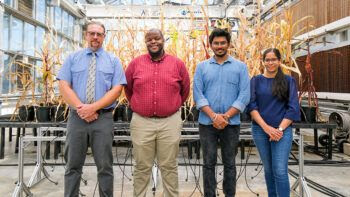|
News Bits
USDA'S GOOD TO EXCELLENT RATING OF CROPS IS THE LOWEST SINCE 2012
by Keith Good, University of Illinois' Farmdoc project
Reuters News reported today that, "Chicago soybean futures rose on Wednesday, recouping the last session's losses, after a weekly U.S. report showed that crop conditions had deteriorated more than expected due to high temperatures."
2023 Crop Progress and Conditions. Charts and Maps. USDA- National Agricultural Statistics Service (September 5, 2023).
The Reuters article stated that, "The U.S. Department of Agriculture (USDA), in a weekly crop progress report, rated 53% of the U.S. soybean crop as good to excellent, down 5% from a week ago and below the 55% expected on average by 11 analysts surveyed by Reuters.
2023 Crop Progress and Conditions. Charts and Maps. USDA- National Agricultural Statistics Service (September 5, 2023).
"The USDA rated 53% of the U.S. corn crop as good to excellent, down 3% from last week and beneath analysts' expectations of 54%.
"The good-to-excellent ratings for both crops are the lowest for this time of year since 2012, a historic drought year. They have renewed concerns about yields, particularly for soybeans, which are at a critical phase of development."
Corn and soybean conditions declined modestly ahead of widespread harvest in the U.S. Corn Belt with both rated 53% good to excellent.
USDA says soybean conditions had the greatest decline in the last week, previously rated 58% good to excellent. As of Sunday, 16% of the soybeans have started dropping their leaves, ahead of average, led by the Delta states.
Corn conditions are a decline of 3 percentage points from the previous week and slightly behind the year ago pace. 18% of the U.S. corn crop is mature, slightly ahead of average.
Spring wheat harvest continues at 74% complete, slightly behind average for this time of the year. Winter wheat planting has just begun with 1% of the crop planted, behind last year and the average.
USDA says U.S. cotton conditions are rated 31% good to excellent, a slight decline from the previous week and below last year. 32% of cotton bolls are opening across the country.
Rice conditions are rated 70% good to excellent, a slight decline from the previous week and year. Rice harvest is 34% complete, ahead of last year and the average.
Sorghum conditions are rated 44% good to excellent, a slight decline from the previous week. Harvest is advancing in Texas and just beginning in Kansas, with 19% of the crop harvested.
Pasture and rangeland conditions are rated 36% good to excellent, an improvement from the previous week and this time last year.
The USDA's weekly crop progress and condition reports run through the end of November.
Iowa State University reports:
While the registration of 2,4-D and dicamba products for over-the-top use in resistant-varieties has improved waterhemp control for many farmers, weed scientists warned that these herbicides would eventually select for resistant waterhemp populations. Bayer recently reported the discovery of two likely dicamba-resistant waterhemp populations in Iowa, which warrants a discussion on best management practices to slow the evolution of resistant waterhemp populations.
On Friday, September 1, Bayer released an external communication reporting that suspected dicamba-resistant waterhemp populations were sampled in Scott County in 2021 and Marshall County in 2022. After extensive screening the company states they are likely resistant to dicamba but will continue testing to positively confirm the resistance. This is the first case of plant growth regulator (HG 4) resistant waterhemp in Iowa, though other states have already documented HG 4 resistance in their own waterhemp populations. HG 4-resistant waterhemp were documented by university researchers in Nebraska in 2009, Illinois in 2016, and Missouri in 2018.
Associated Press reports:
Russian President Vladimir Putin said Monday that the grain deal that allowed Ukraine to export grain safely through the Black Sea won't be restored until the West meets its obligations to facilitate Russian agricultural exports.
Putin made the statement after talks with Turkish President Recep Tayyip Erdogan, who along with the U.N. brokered the deal seen as vital for global food supplies, especially in Africa, the Middle East and Asia. Ukraine and Russia are major suppliers of wheat, barley, sunflower oil and other goods that developing nations rely on.
But Russia refused to extend the deal in July, complaining that an agreement promising to remove obstacles to Russian exports of food and fertilizer hadn't been honored. It said restrictions on shipping and insurance hampered its agricultural trade even though it has shipped record amounts of wheat since last year.
To read the entire report click here.
Editor's Note: Can't say we're shocked by Putin's reluctance to redo the deal.
|
 Texas A&M Agrilife researchers integrating new AI tools for plant analysis
Texas A&M Agrilife researchers integrating new AI tools for plant analysis Texas A&M Agrilife researchers integrating new AI tools for plant analysis
Texas A&M Agrilife researchers integrating new AI tools for plant analysis